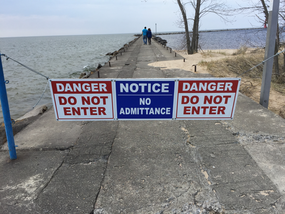So, what is really going on here in this photograph? Some might say that taking a walk on a crumbling structure is a small risk to take to be able to accomplish what they are trying to accomplish, in this case a beautiful walk with no one else around. After all, if they pay attention to where they step and walk in the right places, they “should” be safe, they should be ok…. Right? Ignoring the Danger sign could be considered a small calculated risk.
Safety professionals and supervisors cringe when they are confronted with this type of situation. And, it comes in many different flavors:
So, what do we do when people ignore caution and danger signs? What do we do when people do not follow established procedures? Is it a cultural thing? Is it controllable? The answers are an absolute yes and maybe. Risk taking is in our blood after all. And our culture encourages taking risks. We are encouraged to save time, be macho, work faster, be creative, and impress the boss. We have come to depend on behaviors to fit in, to get noticed and be part of the gang. So what is a manager to do? Take Baby Steps - Changing people’s behavior, and thus the culture, in any situation is a process, it doesn’t just happen. Cultural change needs to be promoted and nurtured with lots of patience over a healthy period of time, such as one to two years or more. Sometimes it will even take a change in personnel to eliminate roadblocks. Recruit Upper & Middle Management Support – From the President, CEO, and the COO on down, support is needed before you can even think about changing your safety culture. The new safety goal must be sold to and agreed upon by top management or it will fall flat. And, make sure upper management walks-the-walk. In other words, make sure they agree to abide by the same principles you are promoting to everyone else in the company. Sometimes it will be as simple as wearing safety glasses when someone is on the shop floor. Other times it will be making decisions that put safety ahead of loading a truck with equipment that should be out of service. Management should be coached to be proactive with safety repairs and look for alternatives, like borrowing a forklift from another department. This may seem obvious, but even seasoned production staff end up in organizational silos when it comes to their department and their priorities. Get Supervisor Buy-in – Make sure management helps you sell and promote the concept to supervisors who are brutalized daily to make production quotas. Supervisors will need to know that safety cannot be sacrificed because of production goals. This will take time for everybody to accept and get use to. And, there will be some that fall off the wagon on the way to achieving that goal, but that should be expected and can be handled in a positive way as a problem-solving opportunity for improvement. Recruit Influencers – Influencers are the popular people, people who other workers look up to or look to for advice about work. Getting them on board can be tricky but can help sell the change at the grass roots level. One way to get them involved is to include them in, or put them in charge of a safety committee whose task it is to help with the cultural change. Maintenance and Facility Manager Buy-In – We should all know by now that keeping equipment and the facility in good working order is a challenge like no other. Often times this part of a company marches to a different drum beat than the production side of the business and they have their own set of unique challenges. Make sure that this group is included in your management, supervisor and influencer buy-in group and that your change plans consider their unique position in helping production fill customer orders on time. After all, maintenance will be the ones replacing machine guards and repairing faulty switches, fixing storage rack supports and replacing worn out wiring, installing the safety signs, mirrors and lighting, to name a few. Be Methodical & Be Positive – Like any good manufacturing project, plan the work and work the plan. Target the unsafe conditions and behaviors in your facility carefully and systematically. Prioritize them based on the frequency and severity of the hazards. Turn an unsafe situation into an operational improvement opportunity. Ask the people exhibiting the unwanted behavior to develop a solution to do the task better, safer and even faster! In most manufacturing environments, employees usually know the problems and solutions before the questions are asked by management. Turn your employees’ problem-solving energy loose in a positive way - to come up with a solution - and everybody wins! So, let’s look at unsafe behaviors with a fresh set of eyes and as opportunities for improvement, and not just another disciplinary problem. Get your management support structure in place and set the employee’s problem-solving energy loose! When employees come up with the solutions, changes are more likely to be adopted and maintained over the long haul. And that is real cultural change! I would bet that you will find that many of the employees wanted to see the change anyway.
0 Comments
|
|


 RSS Feed
RSS Feed
